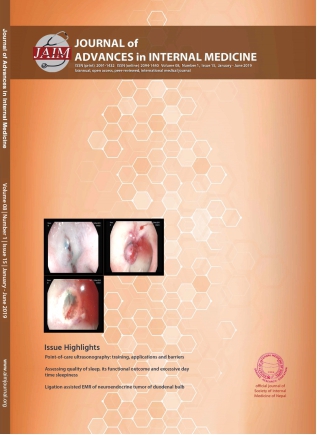Point-of-care ultrasonography: training, applications and barriers. A survey study
DOI:
https://doi.org/10.3126/jaim.v8i1.27995Keywords:
point-of-care ultrasonography, resource limited setting, surveyAbstract
Background and Aims: Use of point-of-care ultrasound (POCUS) in acute care setting has rapidly increased and has potentials to guide patient management. This survey study aims to explore the usefulness of a one-day workshop and to elicit the perceived barriers for effective use of POCUS.
Methods: A total of 169 doctors who had attended one day Acute Care Ultrasound workshop were approached through email. Online link to access the survey created using Google forms was sent. The survey contained questions related to the details about the participants, feedback about the workshop, whether the workshop has helped to change the practice of the participants, availability of ultrasound machine during the daily practice and the perceived barriers for use of POCUS.
Results: A total of 41 responses were obtained. Majority of the participants had anaesthesiology as the base specialty followed by general practice. Most of them had ICU as their predominant working place, followed by emergency room and operating room. The workshop was found to be helpful by most of the participants. Majority of the participants (20 participants; 49%) had ultrasound machine sometimes available during their daily practice. Only 20% (8 participants) had ultrasound machine always available during their clinical practice. Similarly, 46% (19 participants) considered lack of access to ultrasound machine as a barrier for application of POCUS. Significant number of participants considered lack of supervision and guidance (18 participants; 44%) and lack of knowledge and skills (13 participants; 32%) as the barriers.
Conclusions: Majority of the participants found the one-day workshop helpful. Doctors from various specialty, working in acute care setting had participated in the survey. Limited access to ultrasound machine, together with lack of adequate knowledge and skills were perceived as major barriers for effective use of point-of-care ultrasound.
Downloads
Downloads
Published
How to Cite
Issue
Section
License
This license enables reusers to distribute, remix, adapt, and build upon the material in any medium or format, so long as attribution is given to the creator.




